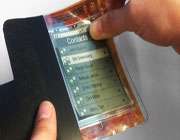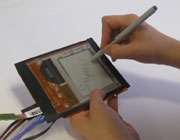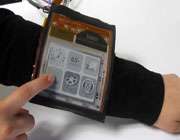
 واضح آرشیو وب فارسی:تبیان: موبایل کاغذیهر روز نمونههای جدیدی از گوشیهای هوشمند روانه بازار میشود. به طوری که برای خرید گوشی، با صدها انتخاب، دهها برند و مدل مواجه هستیم. این روزها گوشیهای هوشمند امکاناتی دارند که 10 سال قبل در فیلمها به عنوان تکنولوژی فوق مدرن معرفی میشد. تکنولوژیهایی که زمانی در حد طرحهای مفهومی بودند و امروزه هر کودک شش سالهای میتواند از آنها استفاده کند. شرکتها و کمپانیهای مطرح دنیا همواره به دنبال کوچکتر و باریکتر کردن محصولات خود هستند. کاربران نیز به خریدن چنین ابزاری تمایل نشان میدهند. به طوری که در بازار رقابت بر سر کاهش چند میلیمتر از ضخامت محصولات است. محققان آزمایشگاه Human Media در کانادا، به سرپرستی Roel Vertegaal موفق به تولید نمونهای شدند که در نوع خود بسیار جالب است. این گوشی باریک تنها ضخامتی به اندازه کاغد دارد و به راحتی در کیف پولتان جا میشود.
واضح آرشیو وب فارسی:تبیان: موبایل کاغذیهر روز نمونههای جدیدی از گوشیهای هوشمند روانه بازار میشود. به طوری که برای خرید گوشی، با صدها انتخاب، دهها برند و مدل مواجه هستیم. این روزها گوشیهای هوشمند امکاناتی دارند که 10 سال قبل در فیلمها به عنوان تکنولوژی فوق مدرن معرفی میشد. تکنولوژیهایی که زمانی در حد طرحهای مفهومی بودند و امروزه هر کودک شش سالهای میتواند از آنها استفاده کند. شرکتها و کمپانیهای مطرح دنیا همواره به دنبال کوچکتر و باریکتر کردن محصولات خود هستند. کاربران نیز به خریدن چنین ابزاری تمایل نشان میدهند. به طوری که در بازار رقابت بر سر کاهش چند میلیمتر از ضخامت محصولات است. محققان آزمایشگاه Human Media در کانادا، به سرپرستی Roel Vertegaal موفق به تولید نمونهای شدند که در نوع خود بسیار جالب است. این گوشی باریک تنها ضخامتی به اندازه کاغد دارد و به راحتی در کیف پولتان جا میشود.

این گوشی هوشمند که به paperphone معروف است، میتواند اکثر کارهای گوشیهای معمولی مانند دریافت و ارسال تماس، ذخیره اطلاعات، نمایش و ذخیره کتابهای الکترونکی، بازی و پخش موسیقی را داشته باشد. اما ضخامت کم تنها ویژگی جالب این موبایل نیست بلکه صفحه نمایش این گوشی بسیار انعطاف پذیر بوده و میتواند خم شود. نکته قابل توجه این است که هنگام خم شدن، گوشی همچنان به کار خود ادامه میدهد و اشکالی در اجرای برنامهها به وجود نمیآید.


گوشی کاغذی که با همکاری دانشگاه Queen’s دانشگاه ایالتی آریزونا ساخته شده است، در مصرف باتری به صورت بهینه عمل میکند به طوری که وقتی از گوشی استفاده نمیکنید مصرف باتری آن تقریبا صفر است. Though we saw another paper phone not to long ago, but the latest paper phone we’re seeing is much more high tech. Like the Kindle, it uses an E-Ink display and works by bending the phone into different positions to make calls, use apps, and listen to music.Created by research teams at Queen’s University in Canada and Arizona State University, the 9.5-centimeter (diagonal) screen is actually a lightweight flexible display. It’s said to feel similar to a bendable piece of plastic.Its thin body resembles that of a paper document, but, according to the video below, underneath the screen is a “flexible printed circuit with resistive bend circuits, which are used to identify the bending of the display screen. The user actually chooses the shape for each function. For example, you can choose to bend the upper-right corner to make a call, or bend the lower left to listen to music. These shapes are then recorded into the software, and when repeated, they send the appropriate action to the device.According to Prof. Roel Vertegaal, director of Queen’s University’s Human Media Lab, the phone does everything a normal smartphone can do. We don’t see any camera as of yet, so it’s missing a feature that’s extremely popular with smartphones, but we know it’s in the early stages, so that could be added in the future. He also said that with larger versions we’ll “no longer need paper or printers. We’re not sure if we’d go so far as to say that, but it can definitely supplement the paper and printers we’ve used for so long. فرآوری : فاطمه مجدآبادیبخش دانش و زندگی تبیانبرگرفته از Geek.com
این صفحه را در گوگل محبوب کنید
[ارسال شده از: تبیان]
[تعداد بازديد از اين مطلب: 415]


















